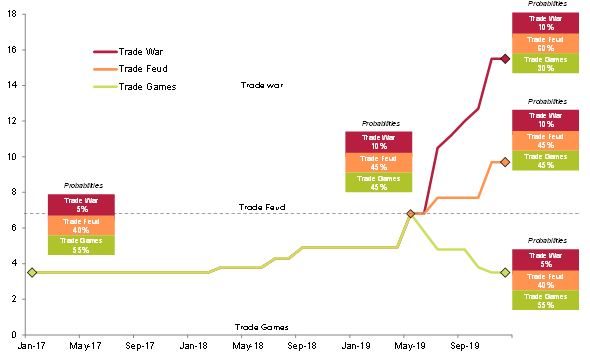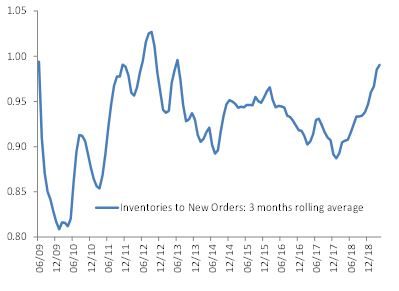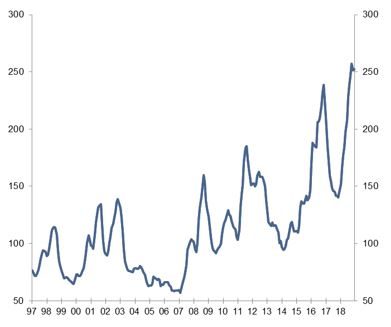Financial repression nurturing self-defeating anticipations
In this context of high uncertainty; rapidly decelerating trade and the pricing by the market of a significant probability of recession, notably in the U.S., major central banks have significantly revised their inflation forecasts on the downside and eased the stance of their communication. Our global inflationary pressure index confirms a comeback to below-target levels of inflation. We are likely to see two rate cuts by the Fed before year-end. Mario Draghi has been very aggressive in reiterating the fact that the ECB is ready to act, should the world economy show further signals of weakness. At the same time, the People’s Bank of China (PBOC) is already engaged in another large monetary stimulus consisting of liquidity injections, fixing new targets of credit distribution to small and medium size companies (+30) or new targets of bonds issuance for local authorities. All in all, major central banks are using the same strategy as seen in recent years, i.e. not hesitating to use all tools available to cut the level of interest rates in order to restart their national economic engines. This so-called financial repression (compressing yields on the downside, even in negative territories) has produced only small results while at the same time nurturing risk. The long-lasting aspect of this medicine and its incapacity to revive growth at a global level have made global investors converge toward expectations of a low growth-low inflation equilibrium, which is today detrimental to growth and investment themselves. Moreover, this context of low yields continues nurturing different bubbles. The risks of a strong adjustment to come are now visible in different segments of the market:
- Global equity markets have decoupled from fundamentals.
- Leverage is globally on the rise.
- Credit quality is deteriorating. The amount of corporate debt noted BBB in the U.S. and in Europe now amounts more than USD 4 trillion in total, representing over 40% of the Investment Grade universe in these two economic areas.
- The risk of a European sovereign-banks negative feedback loop is still there
- China’s financial vulnerabilities are increasing. Worries about financial stability are fully justified as we have seen a regulatory takeover of a small lender (Baoshang Bank, the first such a case in 18 years), followed by episodes of stress in the certificate of deposit market (an essential tool of funding for low rated issuers of debt) and another rescue operation organized by the PBOC in favor of Jinzhou Bank. At the same time, defaults on corporate bonds reached a record high in 2018. In February, a state-owned development company defaulted on U.S. dollar-denominated debt. The situation of banks and corporate debt in China therefore needs to be closely monitored.
Regional scenarios
The U.S. economy is expected to decelerate from +2.9% in 2018 to +2.5% in 2019 and to +1.7% in 2020. We see budgetary negotiations in the U.S. Congress at the end of 2019 as being another major threat weighing on growth. Another government shutdown with more severe repercussions is likely to trigger a correction in the equity and credit markets, with important repercussions for the real side of the economy. A U-turn in U.S. fiscal policy, from being expansionary towards being restrictive, will be the main driver explaining the deceleration of growth over the two coming years, with the possibility of a technical recession taking place in H1 2020 being non-negligible. The Fed is expected to cut the Fed Funds Target rate twice in July and October 2019, as well as in March and June 2020.
The Eurozone is exposed to negative external headwinds, notably due to the U.S.-China trade dispute. Prevailing domestic uncertainty (Brexit, Italy) is also expected to be a drag for the remainder of the year. Overall, we expect GDP growth at +1.2% in 2019-20, well below potential. Several domestic buffers will be at play: (i) the increasingly dovish and “ready to do more” monetary policy; (ii) more fiscal spending (a positive fiscal impulse for the first time in 10 years, which would support GDP growth by +0.2pp) and (iii) the resilient consumer, which enjoys a continued, albeit softer, labor market recovery, which coupled with the lower inflation allows for higher purchasing power. This coupled with low interest rates would remain supportive for the residential market. In our baseline scenario, the ECB will keep interest rates at the current level for the remainder of our forecast horizon in 2019/2020. The most important tool to prolong the current monetary policy stimulus will be the Forward Guidance. If inflation expectations remain at their current low level, the ECB will take steps to steer market expectations, starting with a further delay of policy normalization to 2021 from mid-2020 currently, as well as the drop of a calendar-dependent to an inflation-based Forward Guidance. Should greater downside risks materialize that call for more policy action, we would expect the ECB to resort to additional measures as early as fall 2019. These include a further reduction in the deposit rate to -0.5% – coupled with a tiered deposit rate to alleviate the negative impact on bank profitability – and a restart of its quantitative easing program. Regarding the latter, the ECB may try at first to put a greater focus on purchases of bonds issued by supranational institutions and corporates before resorting to an increase in the issue(r) limit above 33%.
Germany’s export-based economic model, with its focus on industrial goods, is likely to remain under pressure for the remainder of 2019, with the subdued trade outlook, elevated political uncertainty around Italy and Brexit, and car sector troubles unlikely to go away any time soon. Construction and private consumption will continue to be the main pillars of the German economy in the coming quarters, though their strength will start to fade gradually. After all, the domestic economy will not be immune to the industrial soft-patch forever: The longer the current weakness in German industry persists, the more it will also start to affect investment, hiring and spending decisions. Resilient employment levels – thanks in part to the shortage of skilled labor – will help prop up private consumption. However, a rising share of higher disposable income – thanks to robust wage growth and expansive fiscal measures – will flow into savings accounts. Meanwhile, investment will record a more pronounced slowdown as elevated stock levels and subdued demand weigh on production capacity. Only brighter export prospects from Q2 2020 onwards will be able to halt the slowdown in domestic demand and open the door to a broad-based economic recovery in Germany. Overall, we expect GDP to grow by +0.8% in 2019 and +1.2% in 2020.
In France, where GDP growth is expected at +1.2% and +1.4% in 2019 and 2020, against +1.8% in 2018, we foresee a switch between the growth drivers, with domestic demand set to recover as a result of better purchasing power dynamics (+2.7% in 2019, highest growth since 2009). In our view, the evolution should benefit household residential investment the most, as 9.5% of households are again considering buying a new home in the next two years, a high proportion last observed in 2011 and in 2016. Private consumption should benefit also but its growth rate should remain quite subdued (+1.4% in 2019) compared to purchasing power, meaning that household savings will remain high. The other switch is not for the better, since export orders deteriorated markedly over the last few months (particularly for carmakers, electronics, metals and chemicals) suggesting an upcoming sudden stop in export growth in these quite cyclical sectors (demand for aircrafts should continue to grow).
Italy’s economy looks set to expand by a meagre +0.2% this year and +0.4% next year, down from +0.8% in 2018. The sharp growth slowdown is explained by external but above all home-made economic headwinds. After all, Italy stands out as one of the few Eurozone countries that does not have the luxury to fall back on resilient domestic demand during this period of subdued trade growth as domestic political uncertainty continues to weigh on private consumption and investment. Expect concerns around Italy’s fiscal policy to make a comeback as weaker-than-forecasted economic growth, coupled with unrealistic revenue targets, will see Italy miss its 2019 budget target and put the deficit on course to breaching the 3% mark next year. By fall at the latest, we expect the EU to reiterate its call on Italy to correct its fiscal stance as part of the 2020 budget planning round. As budget tensions between Italy and the EU are flaring up again, we once again expect not EU fiscal rules but rather the market to act as a key disciplinary force that will keep Italy from crossing any major red line: rising sovereign credit spreads and the lingering risk of a sovereign credit rating downgrade will ensure that Italy implements another fiscal policy U-turn. What is different from last year is that the Italian government coalition may well fall apart as early as late 2019 over disagreement on where to cut fiscal spending with the Lega and the M5S pursuing very different economic policy approaches. The Lega, according to recent polls, commands a parliamentary majority, together with one-two smaller center-right parties and hence has strong incentives to call snap elections. The debate around the introduction of mini-BOTs as well as the non-observance of EU fiscal rules should hence partially be understood as part of a looming election campaign.
In Spain, it is the end of the economic miracle. Companies should prepare for (i) slower activity (+2% in 2019, +1.8% in 2020, after +2.5% in 2018) as the minimum wage boost of +22.3% in 2019 barely compensates for the slowdown in foreign and domestic demand, and (ii) a re-normalization of competitiveness, with unit labor costs accelerating at the fastest pace in five years, which should negatively impact margins (-1.5pp to 41.5% of Gross Value Added).
Political stability in the UK is fragile. Uncertainty has increased along with the leadership contest in the Conservative Party. Given his harsher stance on Brexit (renegotiation of the Brexit deal and the Irish border backstop without excluding a no deal exit), we have raised our probability for a no-deal scenario on Oct 31st from 25% to 40%. An EU exit under the WTO conditions would only be temporary in our view, given its disruptive impact. Our baseline scenario (50%) remains an extension of Article 50 until mid-2020 or end-2020, possibly accompanied by a referendum. Contingency stockpiling accelerated in Q1 2019 as companies were preparing for a no-deal scenario in March 2019. While there are visible signs that stockpiling is decelerating in Q2, we expect it to pick up again in Q3, ahead of the Oct 31st Brexit deadline. The contingency stockpiling will drive import growth at a very high level in 2019 (around 8% in volume terms). This will happen at the cost of lower margins, given the rise in input prices driven by the sterling depreciation. Hence, the current account deficit should widen to above -4% of GDP. GDP growth is expected to be negative in Q4 (-0.2% q/q). Overall, GDP growth should reach +1.2% in 2019 before slowing to +1.0% in 2020.
Emerging Markets were already affected by the deterioration of the global environment. The lower demand for commodities (particularly metals) had an impact on the main exporters (e.g. Brazil, South Africa) where growth was revised on the downside. The materialization of the trade feud scenario will further exert downward pressures on growth of export-led Asian economies, particularly since electronics was affected by the U.S.-China dispute with the Huawei case. Capital flows have already started to reverse from May, with new U.S. tariffs coalescing with idiosyncratic risks (e.g. Turkey, after the municipal elections). A low growth for longer environment increases the risk of non-payment, which was one of the main triggers of our recent Morocco and South Africa country rating downgrades.
China’s real GDP growth rose by +6.4% y/y in Q1 2019 (a pace similar to Q4 2018). Looking at sub-components, the tertiary sector slowed but remained resilient (+7.0% y/y in Q1 2019 after +7.4% in Q4 2018), industry picked up speed (+6.1% after +5.8%) and primary industry slowed (+2.7% after +3.5%). All in all, these figures confirm our scenario of economic acceleration from Q2 onwards, mainly through domestic demand supported by powerful fiscal and monetary policies. However, the recovery is only state-driven as the private sector does not show any sign of stronger confidence yet. The positive impacts of the recent stimulus will take time to be really visible. All in all, we expect China’s GDP growth to reach +6.3% y/y in 2019, compared with +6.6% y/y in 2018.
In Asia, trade feud/war prospects have already created problems. Economic growth is set to slow in line with slower global trade, in particular for trade-dependent economies ( South Korea, Singapore, Hong Kong, Taiwan, ASEAN), especially in a prolonged trade feud scenario. Yet, emerging markets in the region will continue to grow above the global growth average, benefiting in part from trade diversion as corporates look for cheap alternative hubs of production (e.g. India, Vietnam, Indonesia and Philippines). Policymakers will use their monetary and large fiscal leeway to support their economies this and next year. Apart from Japan, China and India, public finances are generally sound in the region. Yet, China has implemented a powerful fiscal stimulus program this year and Japan has passed a supplementary budget to support reconstruction efforts after last year’s disasters. Japan may also postpone the planned sales tax hike in fall 2019, if needed. We forecast annual growth in the region as a whole to slow from +4.9% in 2018 to +4.7% in both 2019 and 2020.
Since the 2015-16 recession, the Latin American Sisyphus has struggled to push his rock back up the hill. What changed from our March outlook is that the optimism from a more dovish Fed and election hopes have faded due to President Trump’s trade policy moves and weak domestic economic developments. Second, post-election reality checks have materialized after an unrealistic boost in confidence, notably in Brazil and Mexico. As a consequence, there should be no acceleration of growth before 2020 (+2.2%, excluding Venezuela), as 2019 GDP growth should stand at +1.2% after +1.4% in 2018.
In Brazil, the outlook remains grim for this year (+1.1% growth), partly due to the slow progress on reforms and weak cycle. A watered-down pension reform could be passed in H2 and allow some return of confidence and investment in 2020 (+2.5% growth). Argentina is rebalancing and its recession has bottomed out but the election risk has intensified. While it is not our baseline scenario, a defeat of President Macri would put debt sustainability back on the table. Mexico enters a new low-growth regime (+1% in 2019, +1.5% in 2020) as the threat of tariffs and domestic policy uncertainty linger. The story of Andean countries performing better than the others no longer holds. Chile is slowing down, while Colombia’s fiscal accounts are under pressure due to the Venezuelan crisis.
Africa has suffered from the impact of lower global trade growth, since export hubs saw disappointing export figures in H1 (e.g. Morocco, Tunisia and South Africa). We expect this to continue and cut growth significantly. Moreover, Africa has suffered from heightened domestic problems, such as generally abnormal rain conditions and lower agricultural output. Low rains were also negative for power generation and had quite detrimental consequences on the most vulnerable economies, contributing to rising protests (e.g. Algeria, Zimbabwe, Sudan). Overall, the African growth forecast should be cut by about -1pp as a result of these two shocks (1/3 is lower export growth, 2/3 is the impact of low rains) and land at a mere +2% in 2019, which means basically about +0% growth in per capita terms. Main African economies were especially affected by these two aspects, including South Africa, where growth is expected to reach a new low at +0% in 2019.
In Emerging Europe, the EU member economies are behind the curve in terms of the growth slowdown, showing resilience, thanks to robust domestic demand supported by wage growth, supportive policies and a rebound in automotive output in H1. The latter, however, is likely to fade in the coming quarters. Turkey remains in recession and Russia’s growth is stumbling due to oil output cuts impacting exports. Monetary policy is already loose in the Emerging EU and there is little leeway in the near term as inflation has ticked up recently. In contrast, Russia is likely to cut rates in H2 2019. Turkey’s monetary policy leeway is hampered by the ongoing currency crisis. However, there is fiscal policy leeway in most of the region and several countries have already announced fiscal stimulus measures such as rises in public sector wages and social benefits. Yet, caution is warranted in Romania (high fiscal deficit), Hungary (high public debt) and Turkey (rising fiscal deficit). Annual growth in the region as a whole is forecast to decelerate from +3.1% in 2018 to +1.8% in 2019, before picking up to +2.4% in 2020, mirroring the performances of the largest economies, Russia and Turkey.
In the Middle East, annual growth is projected to slow down from +1.3% in 2018 to around +0.5% in 2019, before regaining momentum in 2020 (+1.9%). The slowdown in 2019 is mainly due to a sharp contraction by -7% in sanctions-battered Iran, as well as a marked downward revision in the GCC’s growth outlook (-0.8pp to +1.8%) reflecting the OPEC+ decision to cut oil production quotas to stabilize oil prices. The latter has particularly affected Saudi Arabia, Kuwait and the UAE. Moreover, the balance of risks to our forecasts is to the downside since political risk has increased once again as a result of the markedly stepped-up conflict between Iran and the US. In our baseline scenario we do not expect an outright war between the two sides, but the risk of policy miscalculation leading to war, as well as new proxy wars e.g. in Lebanon, has risen.
Insolvencies to increase by 7% in 2019 and 2020. A higher number of companies will fail to adjust. We expect seven out of ten countries to register an increase in corporate insolvencies in 2019 and one of two countries to end 2019 with more insolvencies than posted annually before the 2008-2009 global crisis. The upside trend would be even more broad-based. Our Global Insolvency Index is forecast to increase by +7%, both in 2019 and 2020, with a still noticeable increase in Asia (+15% in 2019), a rebound in Europe (+3%) and a gradual trend reversal in the US by 2020.








